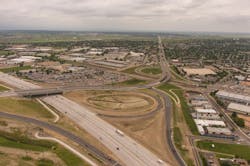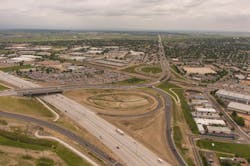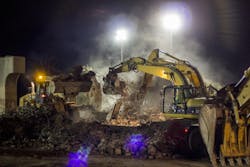Dynamism at work
The advent of widespread public interest and demand in multimodal transportation corridors has, in many ways, mirrored the proliferation of public-private partnerships (P3s) in construction development.
Colorado’s $497 million U.S. 36 Express Lanes project in the Denver metropolitan area aims to offer multimodal capacity, combined with a two-phased approach and an aggressive construction schedule, making this P3 one of the most dynamic in the world of transportation.
Led by the Colorado Department of Transportation (CDOT), the High Performance Transportation Enterprise (HPTE) and the Regional Transportation District (RTD), the project began with an Environmental Impact Statement (EIS) in 2003 that included heavy involvement from local jurisdictions and the public, and helped lay a solid groundwork for eventual development.
The first phase of the project broke ground and began construction in summer 2012 and was just recently completed in summer 2015. Ames Granite Joint Venture was chosen as the contractor for this phase of the project, which covered about 11 miles of the 16-mile-long corridor.
The multimodal U.S. 36 Project will reconstruct 16 miles of highway, more than 10 bridges, and add both BRT access and a diverging diamond interchange for free-flowing traffic.
The demolition of previous bridge structures occurring at night to mitigate daytime traffic impacts.
Rather than simply building additional lanes for a highway that currently carries 100,000 vehicles per day, the U.S. 36 project had one goal—provide choice for a growing population and business community that could move traffic more efficiently well into the future. The project includes reconstructing all of the general purpose lanes of an aging highway, adding an express lane in each direction of the highway, which can be used by buses in a new bus rapid transit (BRT) system, high occupancy vehicles (HOV) and tolled single occupancy vehicles (SOV). The first phase also has reconstructed the highway to accommodate 12-ft-wide inside and outside shoulders; replaced five bridges, namely the Wadsworth Parkway Bridge, the Uptown Avenue Bridge, the Lowell Boulevard and Sheridan Boulevard bridges, and the Burlington Northern Santa Fe Railway Bridge; made improvements to three other bridges (the Westminster Promenade Bridge, the East Flatiron Bridge, and the West Flatiron Bridge); and improved RTD bus stations along the corridor with amenities including new canopies with enhanced weather protection, ticket vending machines and new electronic displays.
Because of the widened shoulders and the goal of moving more people more efficiently, this project allows for bus-on-shoulder access, where buses can operate on the shoulders of U.S. 36 between interchanges when the speed in the general purpose lanes falls below 35 mph to decrease bus travel time and avoid congestion. Intelligent transportation systems (ITS) also are being built for tolling, transit, traveler information and incident management. Part of that system includes active traffic management (ATM) devices that notify drivers in real time about changing traffic conditions, accidents and reduced speeds. And for all of the active Coloradans who live and work between Denver and Boulder, a separate commuter bikeway was constructed so that bikers can commute adjacent to the entire length of the corridor.
The second phase of the project, with boundaries that cover the remaining 5 miles of the corridor, includes the same features as Phase 1. Phase 2, however, is different in that a concessionaire was selected to design, build and finance this portion of the project and to operate and maintain both phases as well as I-25 from U.S. 36 to downtown Denver for 50 years. Plenary Roads Denver was selected as the concessionaire on the U.S. 36 Express Lanes in 2014.
In addition to reconstructing the general purpose lanes and adding an express lane in both directions, this phase also is replacing Coal Creek Bridge, rehabilitating and widening South Boulder Creek Bridge, and widening the McCaslin Boulevard Bridge to accommodate a diverging diamond interchange (DDI), which is a relatively new concept for the state of Colorado, crossing traffic to the opposite side of the road across an interchange so vehicles have unimpeded movement onto the freeway ramps. Just like Phase 1, Phase 2 also will have bus-on-shoulder access, RTD bus station improvements, ITS, ATM and a separate commuter bikeway along the rest of the corridor. Phase 2 construction began in late 2013 and is slated for completion in early 2016.
The P3
The Federal Highway Administration defines a public-private partnership as a “contractual agreement formed between a public agency and a private sector entity that allows for greater private sector participation in the delivery and financing of transportation projects.”
Because Colorado has not been able to raise the gas tax in 23 years and is currently lacking the funds necessary to repair its aging infrastructure and prepare for anticipated growth, the decision to privately fund the U.S.36 Express Lanes Project’s second phase was made in the early planning stages in order to accelerate the construction project. In addition, the concessionaire, Plenary Roads Denver, as aforementioned, assumes the majority of the risk of the project in terms of funding, making the risk low for CDOT and HPTE when it comes to paying back the loans needed for such a large project. Plenary Roads Denver is required to use the toll revenue to repay the federal loans, as well as pay for the maintenance and operations costs of the corridor. If revenues are lower than expected, CDOT and HPTE are not responsible for paying back the loans. If revenues are higher than expected, Plenary Roads Denver shares the excess revenue with the state of Colorado.
When the decision was made to move forward with a P3, a two-phase competitive bid process was used for selecting the concessionaire. The first phase was based on the qualifications of all interested teams, and the initial list was shortlisted to the three teams that had the best qualifications for the project. The second phase included evaluation to select the proposal with the best value, combined with the most effective financing for the corridor. Local governments were consulted throughout the process.
Construction progress
As Phase 1 of the U.S. 36 Express Lanes is complete, with some final touches to be added through the end of September, the express lanes began collecting toll revenue on July 22, 2015. SOVs have begun using the lane by paying a toll and HOVs are taking advantage of the lanes for free if they contain two or more people (the minimum number will go up to three no later than 2017) and have a pass. Buses also are able to use the express lanes currently, although BRT service will begin in 2016, after both phases of the project are complete.
As of August 2015, the second phase of construction was 64% complete. This summer, westbound U.S. 36 traffic was realigned onto new concrete pavement, followed by the eastbound U.S. 36 traffic realignment shortly thereafter. Other summer construction activities included the partial demolition of the west side of McCaslin Boulevard Bridge, including portions of the bridge deck, sidewalk, fencing and curbing. The pedestrian box tunnel, previously under construction, was extended to the west on the south side of McCaslin Bridge, and construction on the eastbound RTD bus ramp progressed fluidly, as girders were installed, the deck was poured and barriers were constructed.
“The Phase 2 fall construction schedule is aggressive,” said Terry Ostrom, Plenary’s Vice President of Project Delivery. “The diverging diamond interchange at McCaslin will be completed this fall, and Phase 2 roadway construction will wrap up by the end of the year.” Other fall construction activities include paving the McCaslin on-ramp to eastbound U.S. 36, ramp and roadway construction at all McCaslin on- and off-ramps, and another McCaslin Bridge traffic realignment so crews can begin constructing the median. Phase 2 bikeway construction and box culvert construction will continue (once complete, the box will have three tunnels, one designated for pedestrian, one for drainage and one for wildlife), and earthwork activities will continue as crews remove and excavate asphalt from the road. Final finish work will take place in early 2016, with Phase 2’s grand opening to follow shortly after.
The simple goal
When all is said and done, the U.S. 36 Express Lanes Project will be as multi-modal as it is innovative. With an emphasis on choice and the involvement of a private partner, U.S. 36 has effectively addressed the saying, “Build more lanes, and they will come,” by finding new ways to manage congestion and fund construction at a time when the state of Colorado has limited resources. Express lanes provide options to the commuter, a return on investment for the financier, and of course, offer an alternative, effective solution when building more lanes is just not enough.
The goals of this project were simple: Be innovative. Think outside the often too-restrictive box and approach transportation in a way that makes sense for everyone. The U.S. 36 Express Lanes Project, from planning stages to scope of work to financing to construction, has applied a thoughtful yet strategic doctrine every step of the way. And when the proverbial rubber meets the literal road, innovation is the only way to move massive amounts of people on limited road space and resources. R&B


